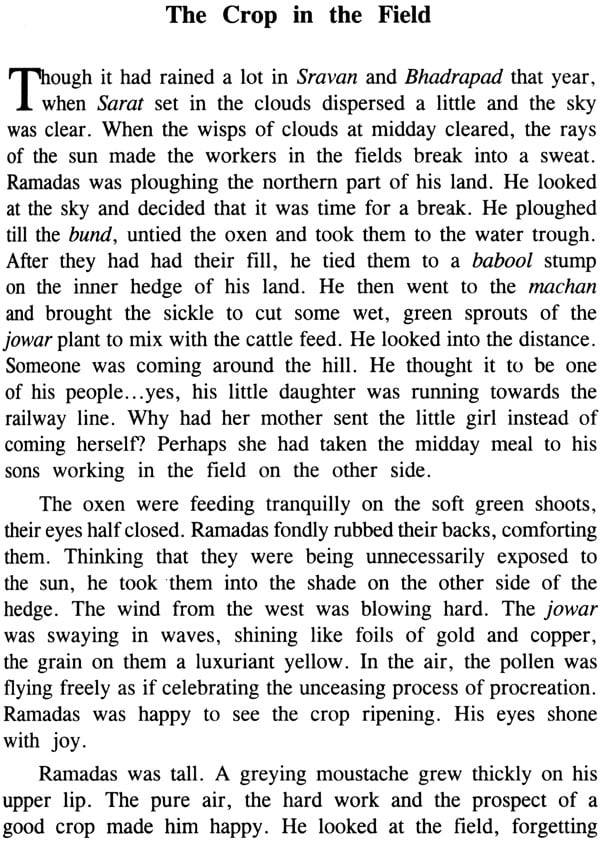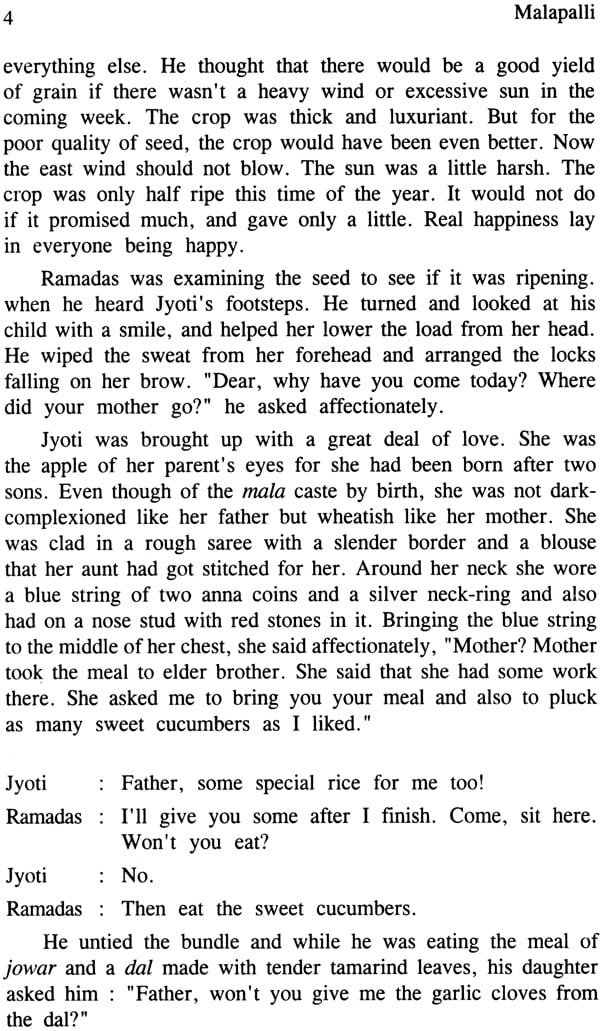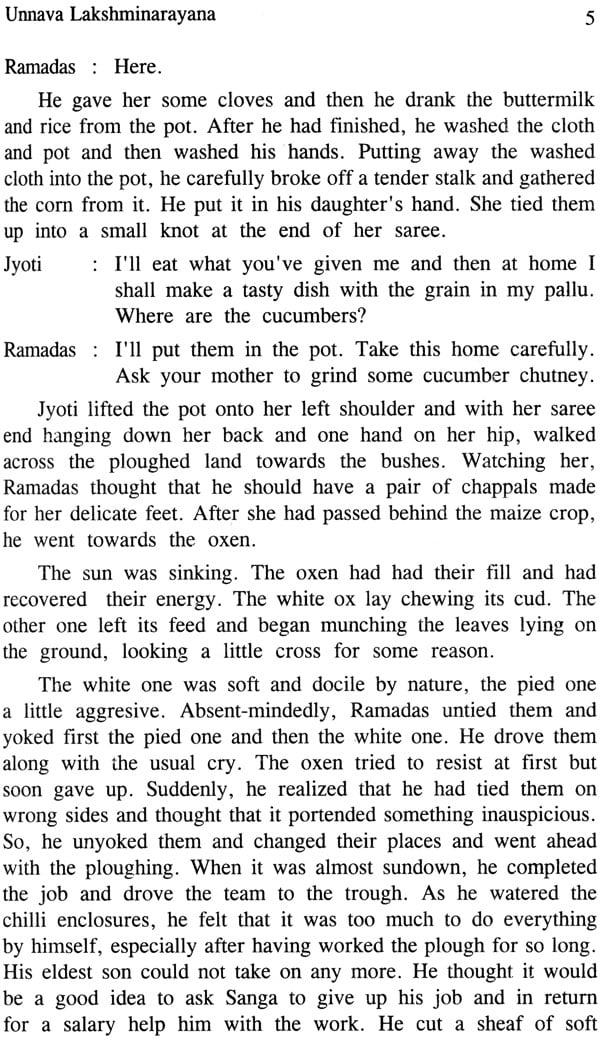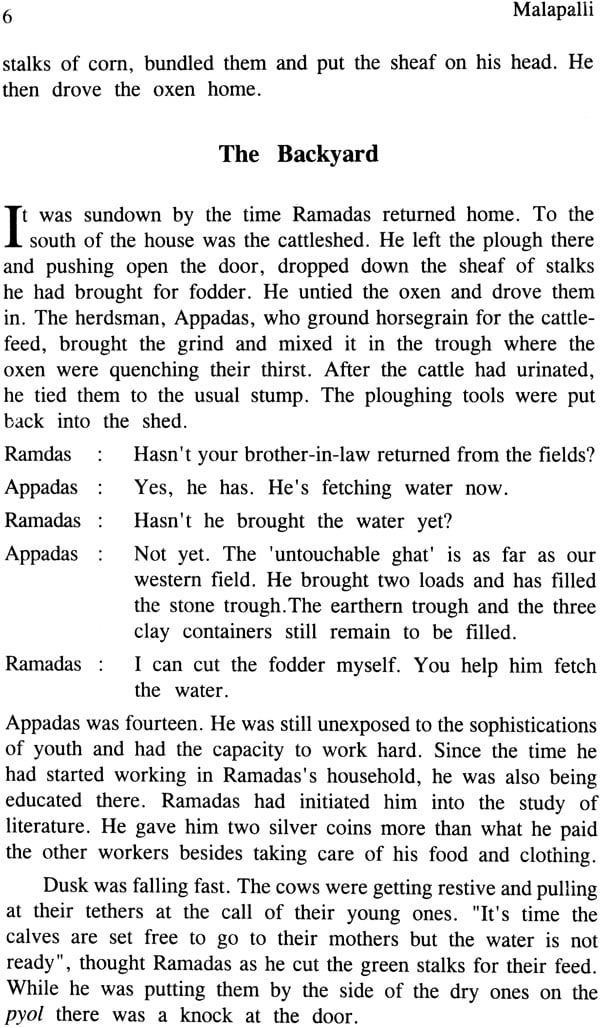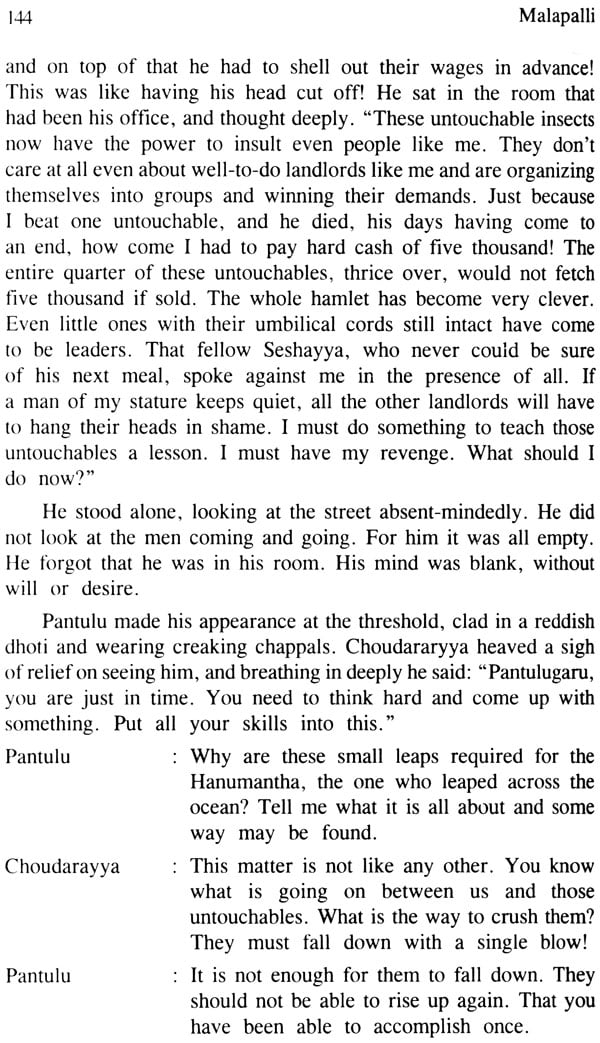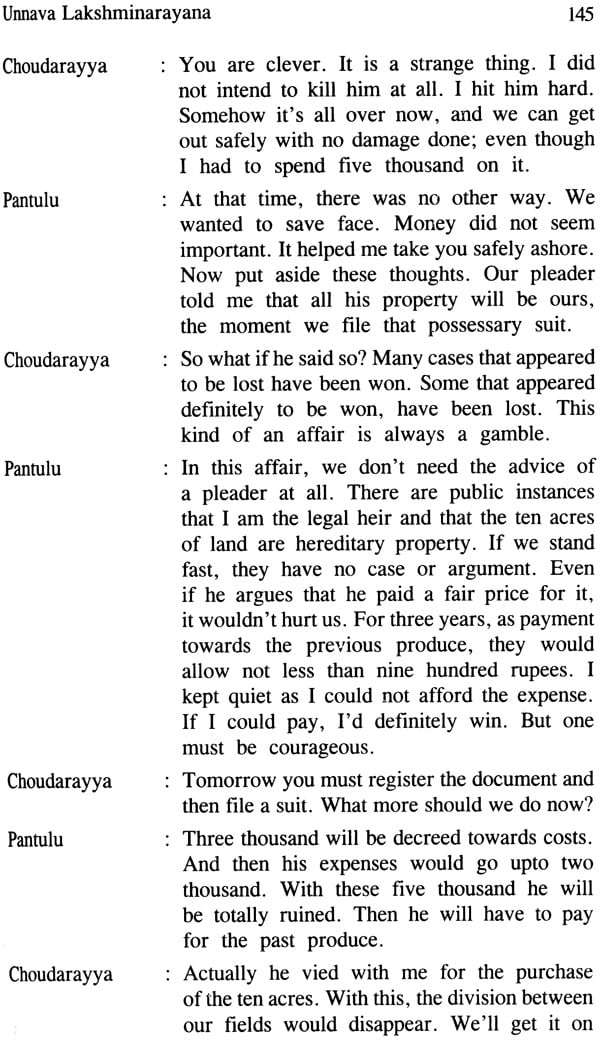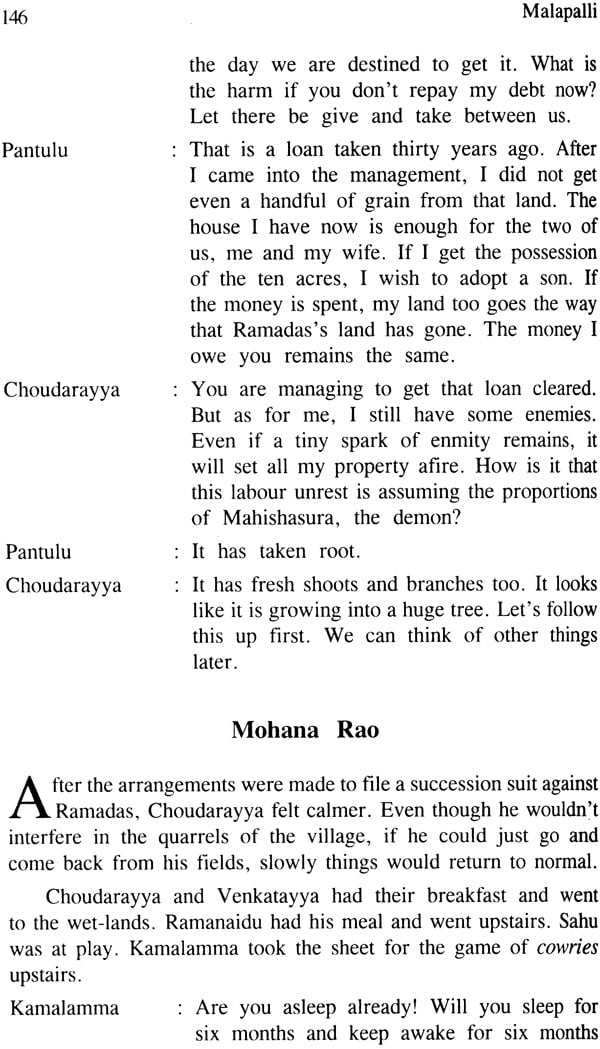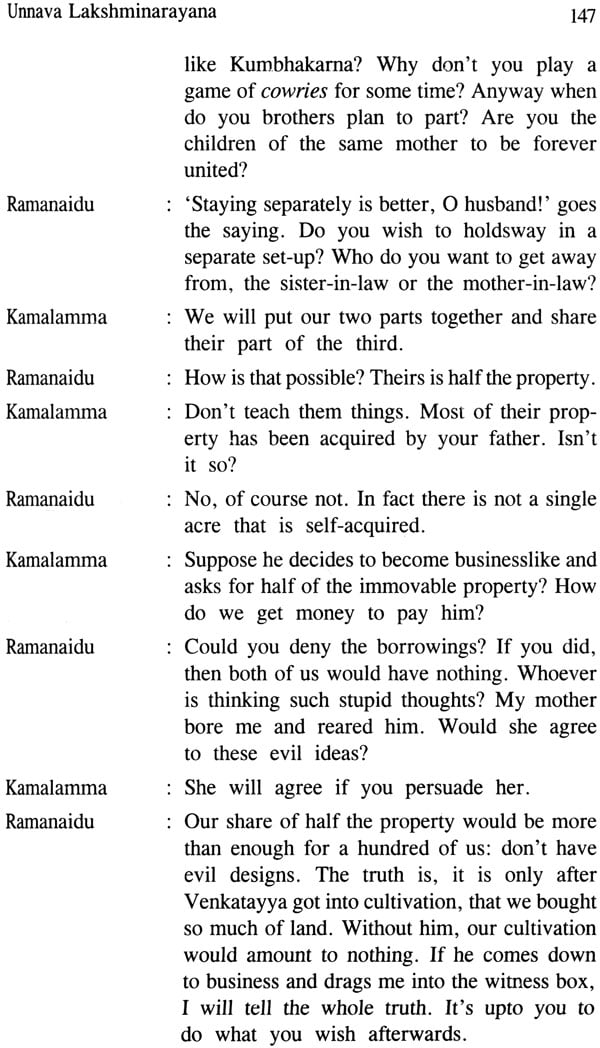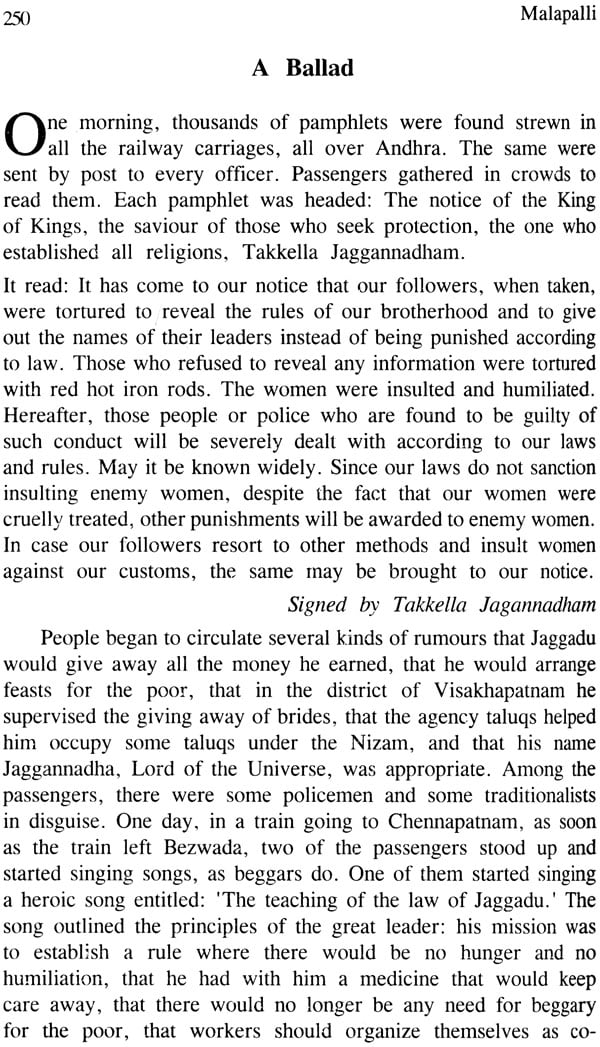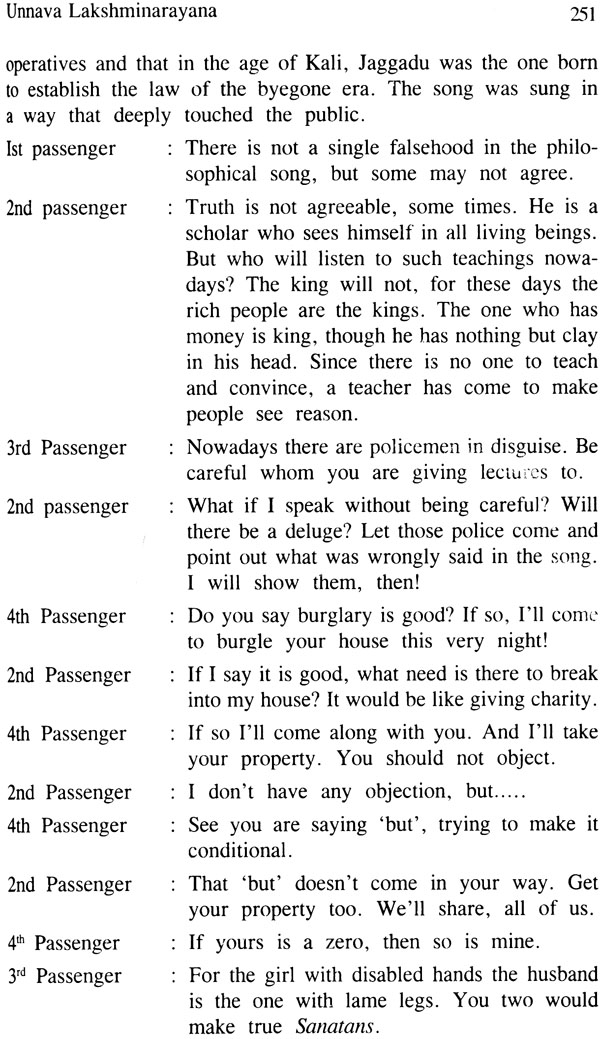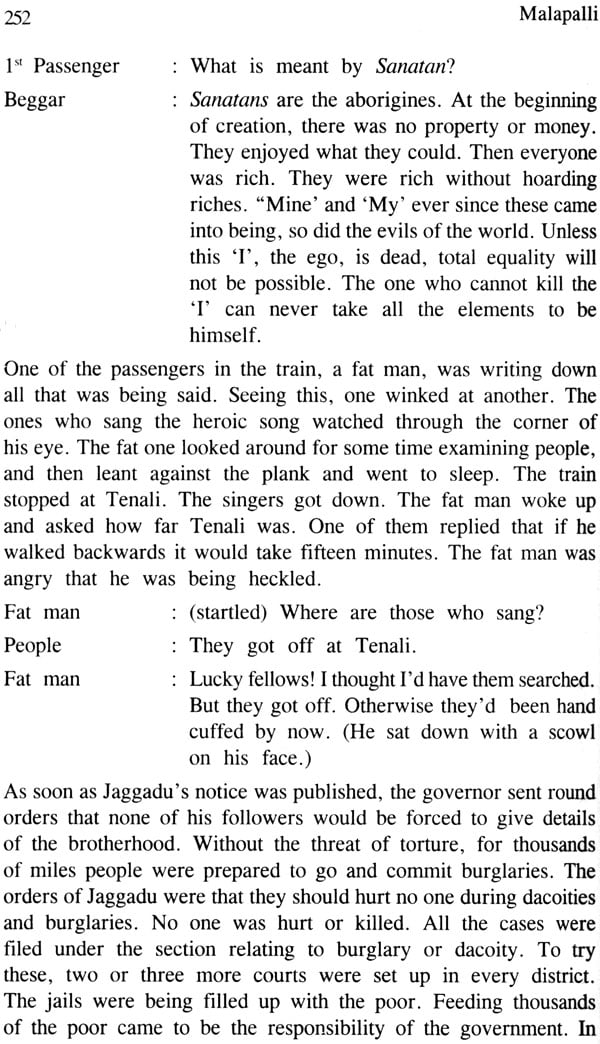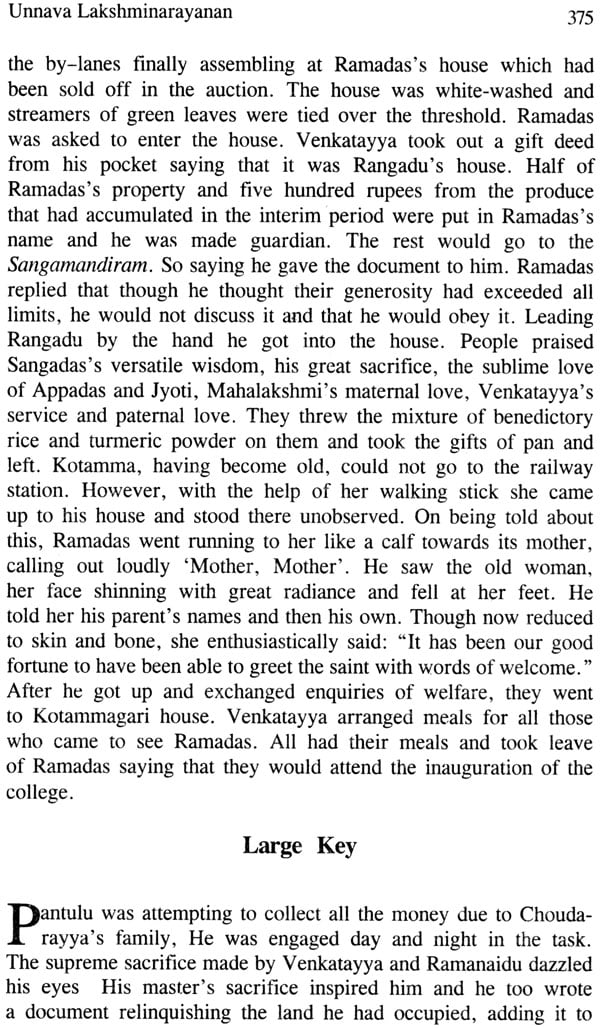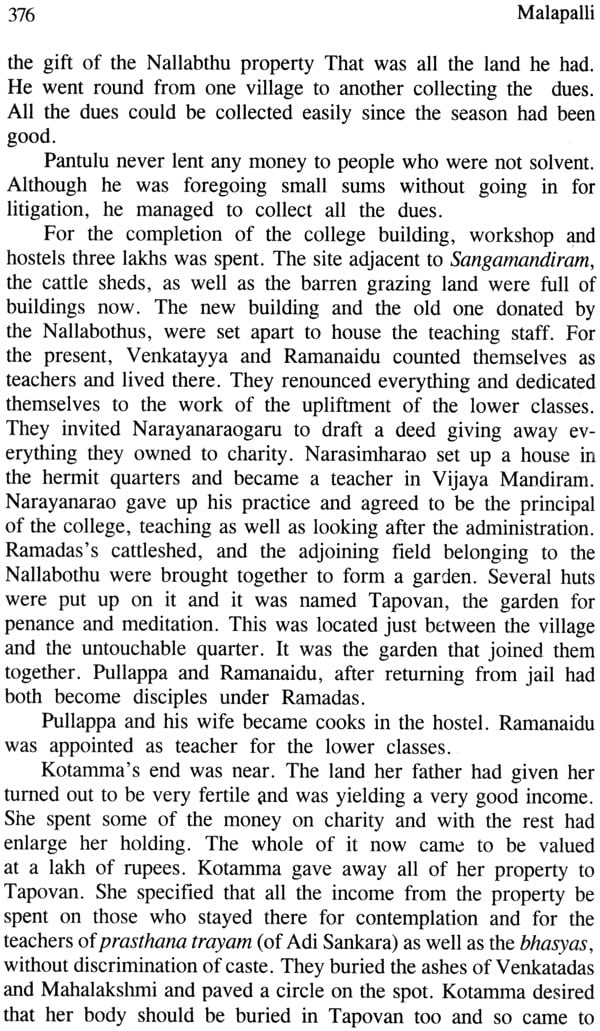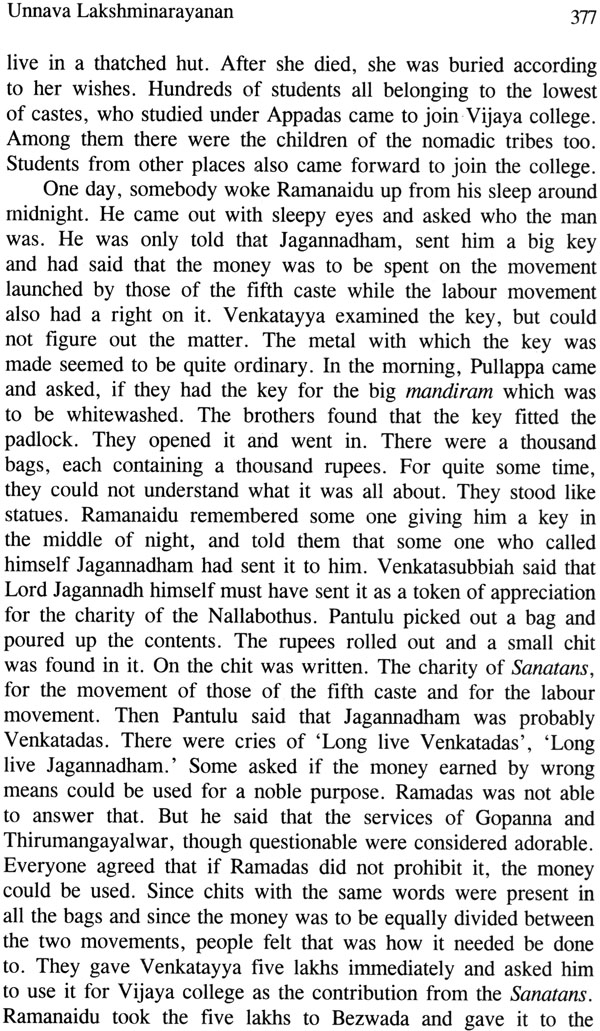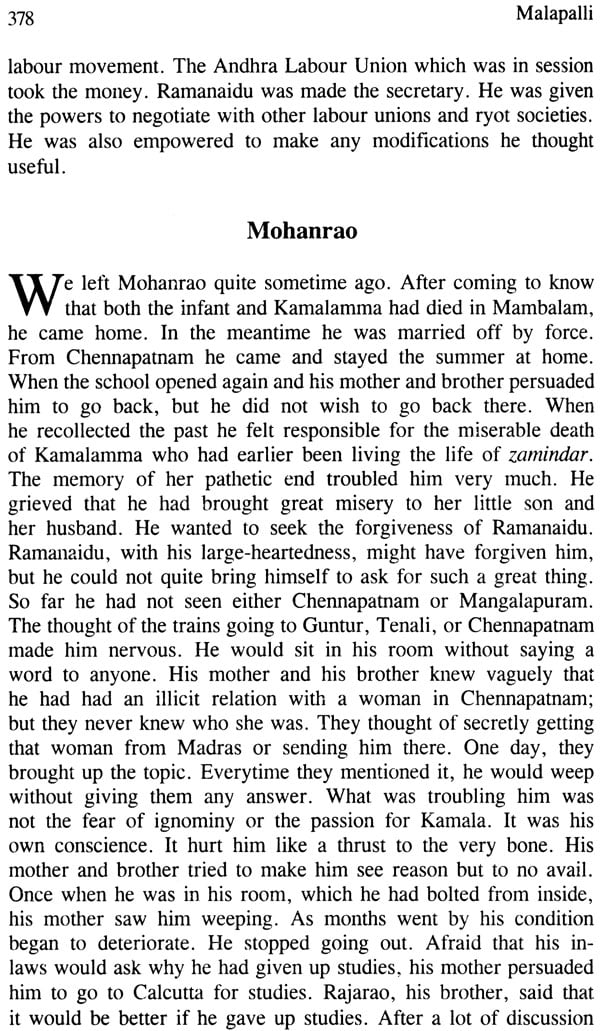
Malapalli : Triumph of Sanga
Book Specification
| Item Code: | NAE844 |
| Author: | V.V.B. Rama Rao and Unnava Lakshminarayana |
| Publisher: | SAHITYA AKADEMI, DELHI |
| Language: | English |
| Edition: | 2008 |
| ISBN: | 9788126025954 |
| Pages: | 403 |
| Cover: | Paperback |
| Other Details | 8.5 inch X 5.5 inc |
| Weight | 520 gm |
Book Description
A novel of events leading to the death of the protagonists and the emergence of a forward looking educational institution is only a part of the brilliant portrayal of the social reality of the 1920s. A sociological novel with a wide canvas, it shows the miserable lot of the ‘untouchables’ and the British system of village and judicial administration, which nurtured foul play. The innocent and virtuous suffer while the crooked thrive. But ultimately it is truth and rectitude that win. Solutions are found in love, rectitude and self-sacrifice.
Unnava Lakshminarayana (1877-1958) trained for legal professional in Ireland, was a patriot fired with zeal. He gave up practice and worked for the upliftment of the lowest of the low, the meek and the humble, widows, orphans and struggled hard in the days when freedom was not a very resounding cry even for the intellectuals. He was one of those firsts who thought of a separate state for the Telugus, a comprehensive Andhra.
V.V.B.Rama Rao (b. 1938) is a creative writer, translator and biographer. Post-graduated form BHU in English, he took his Ph.D from Andhra University. A teacher in English and ELT specialist, he has published eight original works in English, eleven in Telugu and more than 17 translations besides several articles in popular journals. He is now living in Delhi.
This has been my first attempt to write a book in the spoken language. There are no good models. To write in the spoken language, scholarship in Sanskrit or the acquaintance with the prabhandhas in Telugu is not of much use. To be proficient in spoken Telugu, one should have acquaintance with villagers who have no relation with the Sanskrit language. First the Sanskrit scholars and now scholars in English have changed the nature of the Telugu language. It has become the practice to take words either from Sanskrit or English though there are pure Telugu words to express many ideas. For that reason beautiful Telugu words have been thrown into disuse, and hybridization has increased. I have tried my best to write in a way that would facilitate the easy and graceful movement of the Telugu language.
Case, juncture and verb forms are not the same in our spoken language and in the written language. It has become our habit to write in one way and speak in another. Since we have created some artificial forms to be used in writing, if we read the text in the same way, the spoken language may sound a little odd. The word, changed in various ways while writing, would appear strange while reading in the ordinary spoken language. If we begin reading the spoken word in the same way as we speak, then we recognise the taste of the spoken word. Having seen how this first attempt has found response with readers, I wish to write more in the spoken language.
I first wanted to call this book Malapalli. After going some way I felt it would be better to call it sanga vijayam (The Triumph of Sanga). For that reason I have retained both the names. The readers may decide which is better.
In the present situation it would appear easier to write this Book in a scholarly way rather than in the spoken way. Habit is the first reason for this. A lack of full acquaintance with the idiomatic Telugu language is an other reason. Telugu language scholars living in villages are better qualified to write in the spoken language. But I thought that this would be a good opportunity to show a path, and set a trend. I know that even among the protagonists of the spoken language there are difference of opinion on the correct way to write. In this there are both moderates and extremists. Serious discussions from all sides should take place without fail. Even while writing this book in the way I liked, I had it in mind that wherever necessary the usage could be modified. It is the readers who are the better judges as to whether this book is of any use.
Five of the movements for our national freedom were led by Mahatma Gandhi : 1920-22, 1930, 1932, 1940 and 1942. Of these five, the one started in 1920 as the non-cooperation movement attracted the attention of a huge number of people. It novelty and the values it upheld, truth and ahimsa, the spirit of sacrifice leading to mass actions like boycotting of the legislative assemblies, courts, governments jobs and schools drew the participation of the people. The establishment of charkhas, the wearing of khadi, the collection of Tilak Swaraj Fund etc., helped the Congress : enter villages, in a big way. Khilafat and the call for Hindu- Muslim unity created a new awareness among Muslims. The movement for the removal of untouchability raised the self-respect and self-confidence among the malas and the madigas. In villages a sensational leadership of the youth emerged. The message of the Congress which hitherto had stopped short at the boundaries of towns, now addressed the rural population and awakened them.
This agitation was not meant for the benefit of any single individual but for the independence of the whole country. It appeared as if mankind had suddenly awakened and was looking ‘r the proclamation of the self and self-respect, ready to bear loss and difficulties and prepared for any sacrifice. People ere showing unprecedented enthusiasm, passion and devotion towards their leaders.
When they said ‘no more payment of kist’ in Bardoli, Desabhakta Konda Venkatappayya and other leaders immediately followed them saying, ‘Our people are also ready to do so in our Pedanandipadu’. The people of Chirala and Perala, under the leadership of Sri Duggirala Gopalakrishnayya, left their towns demanding the abolition of municipalities had not been which, were not heard of or seen in any epic. In Calcutta, thousands of people boycotted schools under the leadership of Desabhandhu Chittaranjan Das. Only fourteen percent of voters polled in the elections for legislative assemblies. People laid down their government jobs, lawyers gave up practice and set up charkhas, selling khadi as a matter of principle. These were some of the multifaceted manifestations of the movement. Did such a movement find a reflection in contemporary literature? Did poets of renown in those days shape this into literary art? One must say that but for a few poems and songs meant for propaganda, no great work of literature emerged except Malapalli. The contemporary literature did not gain the popularity that was enjoyed by the stories of the Ramayana, Mahabharata and the epics of ancient times. The current trend in literature began to address the contemporary life of the people. Just as the language changed, the subjects of the work of literary art also changed. But even to date, the stories of the Ramayana and the Mahabharatha have not stopped enchanting us. Malapalli has a unique place in literature. It kept the non co-operation movement as the backdrop and against this, it portrayed rural life, the tribulations therein, the problems, the selfishness, the leadership, the main roles of Harijans, sacrifices, strikes, and the facing of tribulations for the sake of ideals. Change in the language, the creation of characters and their development showed a new path. Modern literature is following the same path. Gandhiji was the soul of the movement; Congress, the new awareness of the leadership of the villages, the awakening of Harijans, khadi-these were its limbs.
Sri Unnava Lakshmi Narayanagaru was a barrister. He too was influenced by Gandhiji and leapt into the non co-operation movement. He gave up his profession as a barrister and came to be of assistance to Desabhakta Sri Konda Venkatappayya and others. In 1921 he served a prison sentence of -one year. The novel Malapalli was written in jail. After his release, with the help of his wife Lakshmibayamma, he founded a national school for girls called Saradaniketan. He wrote Nayakaralu and many other books.
Sri Lakshminarayana, apart from being a leader who propagated the ideals of the Congress, also took part in constructive programmes. His Malapalli will remain a pioneering work. Among those with political awareness, no one else has won such renown. Recently Malapalli was presented as a play. It earned the people’s appreciation. This book is written in an educated, conventional and colloquial style. Words used in remote villages are also to be found in the book. Malapalli is a novel which shows a new path in Telugu literature.
Sahitya Akademi had been thinking of publishing an abridged version for quite a long time. This has come to be true now. Triveni Publishers have published the abridged versions which has gone into four hundred pages. The original work has not suffered any damage in abridgement. With the full belief that this book will help students and the youth of this generation to experience, to some extent, the atmosphere created under the leadership of Gandhiji in 1920. I write these few sentences as a foreword. I am confident that the fame and popularity of Malapalli will grow, even further.
| Introduction ( Unnava Lakshminarayana) | IX |
| Introduction (Kasinadhuni Nageswara Rao) | XI |
| Foreword (Bezawada Gopala reddy) | XIX |
| Part One : Sangadas | |
| The crope in the field | 3 |
| The Backyard | 6 |
| The House | 8 |
| The Family | 12 |
| Ramadasin Devotional Frenzy | 13 |
| The Cattleherds | 15 |
| The True Preceptor | 19 |
| Karma Yoga | 23 |
| Worship | 26 |
| Authority | 31 |
| The Temple | 32 |
| The Goddess | 38 |
| Smouldering Fires and Folded Cakes | 41 |
| Twigs for the Sacred Fire | 49 |
| Harvesting | 58 |
| The Merchants | 67 |
| Wage-Earner | 71 |
| The Old Beggar Woman | 80 |
| The Ones with a Right to the Crop | 89 |
| The 'Untouchable' Food | 94 |
| Four Castes and four ways of life | 97 |
| Aryan wisdom is for everyone | 104 |
| Building Society | 107 |
| Don't Forget Me | 112 |
| We Will Win | 120 |
| Part Two : Ramanaidu | |
| Parental House | 129 |
| The Dungeon | 132 |
| Teaching of the Equality Cult | 136 |
| The Last Rites-Sangapeetaham | 140 |
| The Law Suit | 143 |
| Mohana Rao | 146 |
| Treachery | 151 |
| Mother is Missing! | 155 |
| Tara And Sasank! | 160 |
| Don't Search | 162 |
| An Answer | 167 |
| The Multi-coloured Mansion | 173 |
| Evils of Vicious company | 176 |
| Where is Unholiness for a Mother | 183 |
| Smallpox | 187 |
| Santhamma | 191 |
| The Play 'Prahlada' | 198 |
| Lawful Burglaries | 201 |
| The Griffin in the Sky | 209 |
| Sahukrishna | 218 |
| Are You My Kamala? | 223 |
| Part Three : Takella Jaggadu | |
| True Marriage | 231 |
| Burglary in the Vsya's House | 237 |
| Bands of Thieves | 247 |
| A Ballad | 250 |
| Mother and Father | 253 |
| Surety suit | 257 |
| Bharat Krishna Vs Bhaghavat Krishna | 259 |
| May the Bond surivive | 261 |
| I'll Build a House by the River | 262 |
| Heathensin a christian House | 267 |
| christian Teples in settlements | 275 |
| Religious Strikes | 281 |
| My Creation | 287 |
| Lest in Tears You Foot should Slip | 289 |
| Two Gardens of Joy | 293 |
| A Recluse | 298 |
| Love or Ailment | 305 |
| Self-immlation | 312 |
| A Lash of the whip | 318 |
| There is no Salvation when slavery is enjoyable | 321 |
| Valiant Hanuman | 325 |
| The Gypsy Woman | 330 |
| The Case | 338 |
| Part Four: Ramada | |
| Renunciation | 349 |
| A Severe Punishment | 351 |
| Own House | 352 |
| God's History | 355 |
| Boos | 358 |
| Venkatadasu | 363 |
| A Great Radiance has risen intothe sky | 367 |
| Transformation | 372 |
| Liberation | 374 |
| Large Key | 375 |
| Mohanrao | 378 |
| Vijaya college | 380 |
| Conclusion | 382 |
